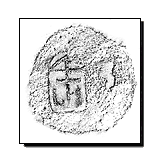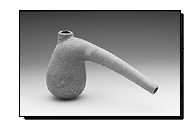AT its opening in 1683, much of the basement area of the Museum was given over to chemistry. Writing in 1684 in his Angliae notitia, Edward Chamberlayne described the area thus: ‘Near adjoyning to the Laboratory are two fair Rooms, whereof one is designed for a Chymical Library … the other is made use of as a Store-room for Chymical preparations, where such as stand in need of them, are furnished at easie rates.’ Immediately behind these rooms were the remains of the city ditch, and it is here that, as reported on the front page, a large hoard of earthenware chemical vessels has recently been discovered.
The laboratory referred to by Chamberlayne occupied the large basement gallery of the Museum. It was then referred to formally as the ‘Officina Chimica’ and was the first university chemical laboratory in England. The chemical library probably occupied the smaller surviving vaulted room in the basement and the storeroom a larger room consisting of the space now taken up by the bottom of the stairwell, which was once also enclosed by a stone vault.
In the seventeenth century and throughout the eighteenth, no internal staircase existed between the chemical laboratory and the two floors above, which housed respectively the School of Natural History and Ashmole’s collection of natural and artificial specimens. This was likely to be for fire reasons and the need to prevent the smoke-filled, noxious atmosphere of the laboratory from pervading the rest of the building.
Chamberlayne described the laboratory and its contents as ‘perchance one of the most beautiful and useful in the World, furnished with all sorts of Furnaces, and all other necessary Materials in order to use and practise.’ Although the basement was isolated physically from what went on above, it was an integral part of the Museum enterprise as a whole. Its operation was overseen by Robert Plot, who was not only the first Keeper of the Ashmolean but also the first to occupy the chair of chemistry in the University created simultaneously.
In 1683 Plot was reimbursed £17 9s for ‘what he has laid out for some vessels etc. for the Laboratory’. Christopher White, the first chemical operator or ‘University Chemist’, was also repaid the large sum of £44 17s for vessels of tin, copper and iron. The best contemporary record of this laboratory equipment comes in a letter written by Plot to explain the different ownership of items present. Even this limited purpose yields an impressive list: ‘the great Alembic, Barrel and Worm, were bought by the University: and so were the great Pewter and small Copper Heads of the Balneum Mariæ, and the Iron pots at the bottom of the Chappel Furnaces. All the ironwork of the Alkanor, the Great Reverberatory was also bought by the University, and all the Furnaces buylt at their charge. The great iron digester at ye West end of the Laboratory is also theirs … ‘.
Plot also mentions ‘small earthen and Glasse-vessels’. The recent archaeological finds sit at this end of the scale, but they must be imagined in the context of the large apparatus of an impressively equipped laboratory. Preliminary reports about them have now been received from the archaeologists, but at this stage it is not possible to date the material precisely. It must have been dumped at some stage after the end of its working life, but it is not known how long after and there is no reason to think that it all dates from the same period.
Open round crucibles, the most common type in the find, are of a design that stretches from the fourteenth century to the modern era; the triangular crucibles are illustrated from the early 16th century and were manufactured in Britain from 1673.

The report on the pottery states that the crucibles ‘cannot be dated with precision on morphological or petrological grounds.’ The base of one crucible has a maker’s mark (illustrated top) which has yet to be identified. The pottery report concludes on the basis of the domestic sherds associated with the crucibles, that the date of dumping is likely to have been in the late 18th century: no earlier than 1770 and probably around 1780. Large numbers of broken fragments of clay tobacco pipes also suggest date limits of 1650 and 1770.
So far as the historical evidence is concerned, the most likely occasion for a general clearing out of material from the basement occurred in the context of the first recorded substantial renovation of the laboratory, which was associated with the appointment in 1781 of Martin Wall as Reader in Chemistry. At this time anatomy teaching had recently moved away from the Museum, so this explanation also accounts for the presence of bones in the find.
The chemical section of the find includes eighteen open-mouthed, round chemical crucibles, ranging in height from 35 to 100 mm and in diameter from 45 to 95 mm. Two crucibles are ‘closed’, that is, their curved sides return to a smaller diameter at the top; it is thought that they may have been for heating volatile metals such as mercury or zinc. There are five triangular crucibles: a small one with sides of 38 mm in length and four larger ones with sides of up to 100 mm. Two retorts (one complete, shown below, and one incomplete), two ‘flasks’ (both incomplete) and a stoneware bottle, together with a large number of fragments, make up the collection. Most of the vessels are of the same material, described as a ‘very hard, white, semi-vitrified fabric with moderate sub-rounded quartz up to 1 mm and sparse sub-rounded red and black ironstone up to 0·5 mm.’
Significantly, a number of the crucibles contain chemical residues. Analysis of these has begun and indicates substantial residues of lead, zinc, sulphur and other elements that one might expect to find in apparatus used in early chemical work. Further analysis may allow links to be made between vessels and experiments known to have been undertaken in the basement, although only a few records of activities in the 18th century survive, when teaching and research would both have required this sort of apparatus.

After the completion of all the reports it will be possible to give a fuller account of the form and use of individual vessels. Descriptions will be published in the catalogue accompanying the first exhibition in the new special exhibitions gallery, which will take place, appropriately enough, over the exact spot where the vessels were buried and subsequently discovered.
From the preliminary studies alone, it is clear that the vessels represent the most significant archaeological find of chemical apparatus yet made in this country and that they have much to offer our understanding of the history of chemistry in Oxford and of the building with which it is inextricably linked.
